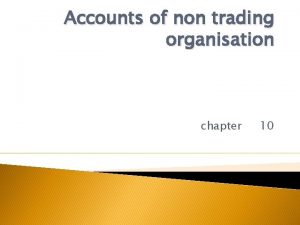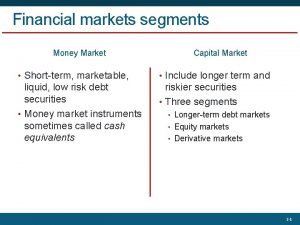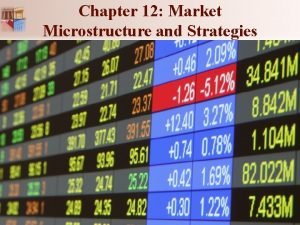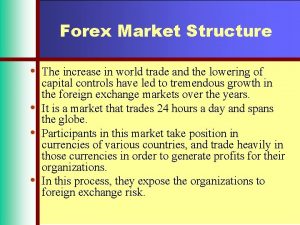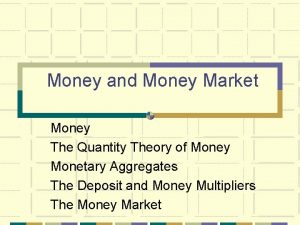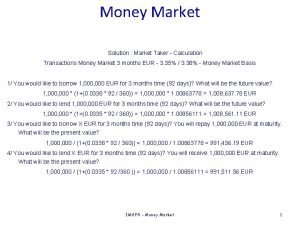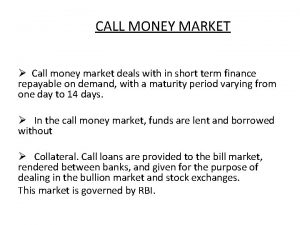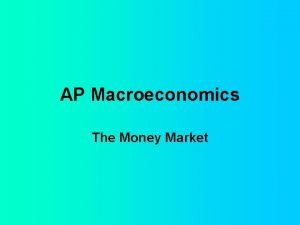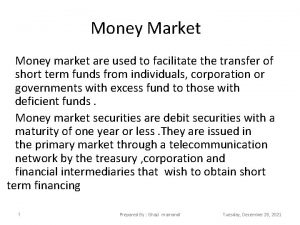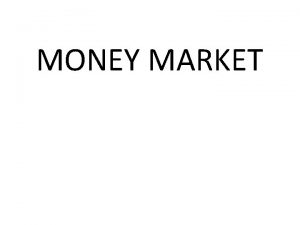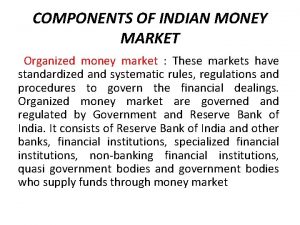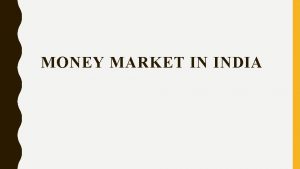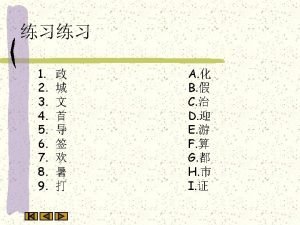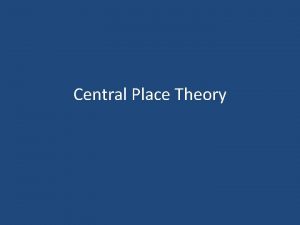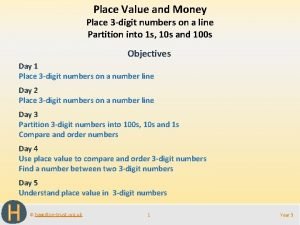MONEY MARKET MONEY MARKET A place for trading
















































- Slides: 48

MONEY MARKET

MONEY MARKET A place for trading in money and short term financial assets that are close substitutes for money. It provides an opportunity for balancing the short term surplus funds of the lenders/investors with the short term requirements of borrowers.

Definition of Money Market The definitions by various personalities are given as : Geoffrey Crowther in his book “An Outline of Money” has stated : “Money market is a collective name give to the various forms and institutions that deal with the various grades of near money. ” J M Culbertson in his book “Money and Banking” has defined money market as “a network of markets that are grouped together because they deal in financial instruments that have a similar function in the economy and are substitutes from the point of view of holders. thee instruments of money market are liquid assets: that mature within a short period of time or callable on demand. ”

an h t s les f o ity ear r u t Ma one y ce of a l p d e x i f o N activity et k r a m s u o n e Homog Mon ey or near asse mon ts ha ey ving h liqui dity igh Money and short term financial assets th or i w s n o i t c Transa kers o r b t u o h t wi

Features of Money Market Following are the general features of a money market: • Liquidity of assets: The assets dealt here are highly liquid i. E. Money or near money assets that could be easily converted into cash. • Maturity of assets: The assets enjoy a maturity period of less than one year. • Place of dealing: There is no fixed place of activity; it could be conducted over telephone, mail etc • Type of assets: The market trades in short term financial assets. • Type/nature of market: The market comprises of several sub-markets making it homogenous in nature. • Brokers: Transactions can be conducted with or without the help of brokers.

Objectives of Money market Transferring surplus of funds from one to another A Surplus funds MONEY MARKET Equilibrium in market B Access to users of short term funds to meet their requirements. Deficit funds Following are some of the important objectives of a money market: 1. Provides access to users of short term funds to meet their requirements at reasonable cost. 2. Helps in transferring surplus from one sector to another. 3. Provides a mechanism for maintaining equilibrium in the short term surplus and deficits of funds in the market.

Distinction between Capital and Money market Basis of distinction 1. Type of assets 2. Use of finance 3. Maturity of assets 4. Connecting link Capital market deals in medium and long term financial assets. Money market deals in money and shot term financial assets. The finance provided under capital market may be used for both fixed and working capital. The maturity of assets under capital market is more than one year. The finance provided under money market is usually utilised for working capital. The maturity of assets under money market is less than a year. It acts as a link between the investor and the entrepreneur. It acts a link between the depositor and the borrower.

Basis of distinction Capital market Money market 5. Principal functions Mobilization and effective utilization of resources are the main functions of capital market. Money market has lending and borrowing as the principal functions to facilitate adjustment of liquidity position. 6. Type of instruments The instruments dealt under capital market are shares, debentures, bonds etc. 7. Funds to Capital market provides long term funds to central and state government public and local bodies for development purposes. The instruments dealt under money market are commercial paper, treasury bills, certificate of deposits, commercial bills etc. The money market provides short term funds to government and others by purchasing treasury bills, discounting bills of exchange etc.

Features of developed Money Market • A developed commercial banking system : For a developed market the banking system should be well organised. As commercial banks are the major suppliers of short term funds, their policies have a great impact on the entire money market. Thus the developed, organised and integrated Commercial banking system makes the money market a developed market. • Presence of a central bank : In developed money market, there is a apex central bank – the head of banking authority which controls, regulates and guides the money market. Thus the influence of central bank on the money market makes it a developed market.

• Sub markets : A money market is a group of several sub-markets dealing in loans of various maturities. The existence of these markets, their integration, coordination and responsiveness to small changes in interest and discount rates makes it a developed money market. • Near money assets : To make a money market developed market there should be large quantity and variety of financial instruments. More the number of near money assets, the market will be more developed. • Availability of ample resources : A developed money market is the one having access to ample resources from both within and outside of the country i. e. the foreign funds.

• Integrated interest rate structure : A developed money market should have an integrated interest rate structure. The interest rates in various sub-markets should be integrated. • Other factors : Other factors which are responsible for the money market to be a developed one are volume of international trade, stable political condition, absence of discrimination, war, recession, depression etc.

Importance/Functions of Money Market • Economic development : The market provides funds to both public and private institutions who need money to finance their capital needs. The advantage of liquidity help to promote trade, commerce and industry. • Borrowings by the government : Money market helps the govt. To borrow short term funds at a low rate of interest. Else the govt will resort to deficit financing or printing more notes increasing the money supply and the price level. • Mobilisation of funds : Money market helps in transferring funds from one sector to another, thus mobilising the resources and contributing in country’s development.

• Self sufficiency of commercial banks : Money market relieves commercial banks to borrow from central banks at higher interest rates instead they can recall some of their loans. • Savings and investments : By promoting liquidity and safety of assets money market encourages savings and investment. More savings and investments will mean more funds. • Importance for central bank : Money market is of utmost importance for the central bank to control the banking system and to contribute towards the development of trade and commerce. Money market being homogenous market is affected by a change in one of its sub-markets. Thus bank can affect the whole market by changing just one sub-market.

Money Market And Its Components Money Market Components Instruments Institutions



Call Money Market • Market for very short period • Brokers and dealers in stock exchange borrow money at call from commercial banks • For very short period • No collateral securities, high liquidity • ROI changes several times during a day


Collateral loan market • Loosely organized and specialized • Loans advanced by commercial banks • Collateral loans are backed by securities, stocks and bonds • If borrower is unable to pay, collateral becomes property of lender


Acceptance Market • Market where bankers’ acceptances are easily sold and discounted. • Short term credit by exporters to get paid faster for their exported goods. • Are used in primarily international trade • Were used in London money market • Lost significance in Indian Money Market.


Bill Market • A market in which short term bills are dealt in. • The duration of bill is generally 90 days • Types of bills: Bills of exchange and treasury bills

d g uirin q e r der r o n yee itte r a w p r A yo r o t a sign term c t r o h s A price son r e p a re nt yie e m u r t s dit in ldin to xe i f a pay st bu e r e t n i o gn t is nt u o m a to isco d a t a d sue unt

a M l l i B a i d n I n i t e rk • Preference to cash credits over bill financing • Lack of uniform practice • Excessive stamp duty • Limited discounted services • Banks prefer to hold bill till maturity, thus affecting circulating of bills.

BILL MARKET SCHEMES Bill Market Scheme 1952 • Reserve Bank undertook to advance loans to commercial banks against their demand promissory notes supported by the security of bills of their constituents or customers. • Before 1952, the practice was that the banks could secure additional cash from the Reserve Bank only by selling government securities to it. • a bank could grant loans to its customers against their promissory notes and can further use the same promissory notes to borrow from the Reserve Bank. • Soon the bill market scheme became popular. The loans granted under the scheme increased • The bill market scheme introduced in 1952 was in fact a pseudo bill market scheme

The New Bill Market Scheme 1970 • A committee headed by M Narasimham proposed formulation of a genuine bill market. • Introduced measures to develop bill market • More charges were imposed on alternative methods like cash credit

Working Group on Cash Credit System 1993 • Committee headed by R. Jilani recommended steps to promote bill culture • Public sector enterprises were encouraged to adopt the bill system • RBI discouraged the use of cash credit.

The Institutions of Money Market The institutions of money market are those which deal in lending and borrowing of short term funds. These are not same in all countries of the world , rather they differ from country to country. Some major institutions of money market are : • • • Commercial Banks. Central Bank. Acceptance Houses. Non-Banking Financial Intermediaries. Bill Brokers.

1. COMMERCIAL BANKS • • • Back bone of the money market. They lend against promissory notes and through advances and overdrafts. The commercial banks put their excess reserves in different forms or channels of investment. 2. CENTRAL BANKS • It is regarded as an apex institution (the monetary authority). No money market can exist without the central bank. • It raises or reduces the money supply and credit to ensure economic stability in the economy. • The performance of the central bank depends on the character and composition of the money market. • But it does not enter into direct transactions, it controls the money market through changes in the bank rate and open market operations.

3. ACCEPTANCE HOUSES • The institution of acceptance houses developed in England where merchant bankers transferred their headquarters to London money market in late 19 th and the early 20 th century. • They function as intermediaries between importers and exporters, and between lenders and borrowers in the short period. 4. NON BANKING FINANCIAL INTERMIDIARIES In non-banking financial intermediaries we include : ü Savings banks ü Investment houses ü Insurance companies ü Building societies ü Provident funds ØOther business corporations like chit funds.

MONEY MARKET INSTRUMENTS The following are the instrument that are available in the money market. • Commercial Bills • Treasury Bills • Call and Short Notice Money Market • Certificate of Deposits • Commercial Paper • Repurchase Agreement • Inter Bank Participation Certificate

COMMERCIAL BILLS Commercial Bills or Bills of exchange is a return instrument containing an unconditional orders. • Once the buyer signifies his acceptance the bill itself it becomes a legal document. • RBI stated making efforts in this direction in 1952. however, a new and proper bill market was introduced in 1970. • TREASURY BILLS (TBS) • • The treasury bill is a short-term government security. Usually of the duration of 91 days. Sold by the central bank on behalf of the government. Treasury bills are highly secured and liquid because of guarantee of repayment assured by RBI who is always willing to purchase or discount them.

CALL AND SHORT NOTICE MARKET • Call money refers to a money given for a very short-period. • For a day or overnight but not exceeding 7 days. • The interest rate is very low on call funds. • Any variation of call money is NOTICE MONEY which can be for a period upto 14 days. CERTIFICATE OF DEPOSITS (CDS) As per the Reserve Bank of India, Certificate of Deposits(CD)is a negotiable money market instrument and issued as a promissory note against funds deposited at a bank or other eligible financial institutions for a specified time period. They are liquid and riskless in terms of default of payment of interest and principal.

COMMERCIAL PAPERS (CPS) • CPs are short-term promissory notes issued by reputed companies with good credit standing and having sufficient tangible assets. • CPs are unsecured and are negotiable by endorsement and delivery. CPs are normally issued by : • The bank • Public utilities • Insurance and finance companies The buyers of CPs includes : • Banking financial institutions • Non-banking financial institutions.

INTER BANK PARTICIPATION CERTIFICATES (IBPCS) IBPCs are the inter bank money market instruments used by commercial bank to park their surplus funds. These IBPCs are of two types : § With risk sharing IBPCs § Without risk sharing IBPCs.

FEATURES OF THE INDIAN MONEY MARKET • In Indian money market, RBI occupies the pivotal position. • The Indian money market can be divided into two sub sections: 1)UNORGANISED 2)ORGANISED ü The organised sector comprises of: §Reserve Bank of India §SBI group and commercial banks üForeign, public sector and private sector banks ü The unorganised sector comprises of : §Moneylenders §Indigenous bankers.

PLAYERS IN THE INDIAN MONEY MARKET • Reserve Bank of India • Financial institutions like IFCI, ICICI, LIC, UTI. • Commercial banks including scheduled as well as non scheduled banks • Discount and Finance House of India • Brokers • Provident Funds • Public sector Undertakings • Corporate Units etc.

DEFECTS OF THE INDIAN MONEY MARKET (1)EXISTENCE OF UNORGANISED MONEY MARKET: In this segment of the market the purpose as well as period are not clearly defined. The segment undermines the role of the RBI in the money market. (2)LACK OF INTEGRATION: There is lack of integration of different segments or functionaries. (3)DISPARITY IN INTEREST RATES: There are different types of interest rates prevailing in the market at the same time like borrowing rates of govt. , rates of financial institutions etc. this was basically due to the mobility of funds from one sub-segment to another.

(4)SEASONAL DIVERSITY OF MONEY MARKET: There are wide fluctuations in the interest rates in the money market from one period to another. (5)LACK OF PROPER BILL MARKET (6)LACK OF VERY WELL ORGANISED BANKING SYSTEM: A well developed banking system is essential for money market.

THE REFORMS IN THE INDIAN MONEY MARKET • VAGHUL COMMITTEE on money market, SUKHMOY CHAKRAVARTY COMMITTEE on the Review of the working of the Monetary system and the NARSIMHAM COMMITTEE on the working of the financial system have made important recommendations on the Indian money market. • The RBI has started the process of implementation of these recommendations: (1) DEVELOPMENT OF THE MONEY MARKET INSTRUMENTS: This includes the introduction of new instruments such as 182 days treasury bills, longer maturity bills, dated government securities , certificate of deposits & commercial papers, 3 -4 days repos and one day repos. It also includes the reintroduction of 182 days treasury bills.

(2) DEREGULATION OF INTEREST RATES: IN 1988, RBI removed the ceiling of 16. 5 percent and fixed a minimum of 16 percent p. a. (3) INSTITUTIONAL DEVELOPMENT (4) MONEY MARKET MUTUAL FUNDS (5)PERMISSION TO FOREIGN INSTITUTIONAL INVESTORS (FIIs).

GROWTH IN INDIAN MONEY MARKET India has witnessed tremendous growth of Indian Money Market. But compared to London money market & New York money market, Indian money market is far away from being called a developed money market.

REASONS PRIVATISATION IN BANKING SECTOR REGULATION & CONTROL BY RBI REVIEW LEGISTATIONS

MONENTARY POLICY INCREASED INCOME LEVEL VARIOUS REFORMS

INVESTMENT HABITS DEFAULTS IN PAYMENT ON MATURITY ( COMMERCIAL PAPERS) PRESENCE OF INDIGENOUS BANKERS

CONCLUSION • We have studied meaning & instruments of money market. Also various reforms of Indian money market. Thus at the end we can conclude that Indian money market is developing at good speed.

 Receipt and payment account
Receipt and payment account Money money money team
Money money money team Financial market segments
Financial market segments Money market components
Money market components Market microstructure trading strategies
Market microstructure trading strategies Stock market virtual trading
Stock market virtual trading Stockspotter.com
Stockspotter.com Fx market structure
Fx market structure Stock market trading stocks
Stock market trading stocks Market abuse indicators
Market abuse indicators Millions billions trillions chart
Millions billions trillions chart A repeating disturbance that transfers energy
A repeating disturbance that transfers energy A disturbance that transfers energy
A disturbance that transfers energy Market follower
Market follower Positioning targeting and segmentation
Positioning targeting and segmentation Fspos
Fspos Typiska novell drag
Typiska novell drag Nationell inriktning för artificiell intelligens
Nationell inriktning för artificiell intelligens Vad står k.r.å.k.a.n för
Vad står k.r.å.k.a.n för Shingelfrisyren
Shingelfrisyren En lathund för arbete med kontinuitetshantering
En lathund för arbete med kontinuitetshantering Särskild löneskatt för pensionskostnader
Särskild löneskatt för pensionskostnader Tidbok yrkesförare
Tidbok yrkesförare A gastrica
A gastrica Densitet vatten
Densitet vatten Datorkunskap för nybörjare
Datorkunskap för nybörjare Stig kerman
Stig kerman Debattartikel mall
Debattartikel mall Magnetsjukhus
Magnetsjukhus Nyckelkompetenser för livslångt lärande
Nyckelkompetenser för livslångt lärande Påbyggnader för flakfordon
Påbyggnader för flakfordon Arkimedes princip formel
Arkimedes princip formel Svenskt ramverk för digital samverkan
Svenskt ramverk för digital samverkan Jag har nigit för nymånens skära
Jag har nigit för nymånens skära Presentera för publik crossboss
Presentera för publik crossboss Teckenspråk minoritetsspråk argument
Teckenspråk minoritetsspråk argument Vem räknas som jude
Vem räknas som jude Treserva lathund
Treserva lathund Epiteltyper
Epiteltyper Claes martinsson
Claes martinsson Cks
Cks Lågenergihus nyproduktion
Lågenergihus nyproduktion Mat för idrottare
Mat för idrottare Verktyg för automatisering av utbetalningar
Verktyg för automatisering av utbetalningar Rutin för avvikelsehantering
Rutin för avvikelsehantering Smärtskolan kunskap för livet
Smärtskolan kunskap för livet Ministerstyre för och nackdelar
Ministerstyre för och nackdelar Tack för att ni har lyssnat
Tack för att ni har lyssnat Referatmarkering
Referatmarkering
